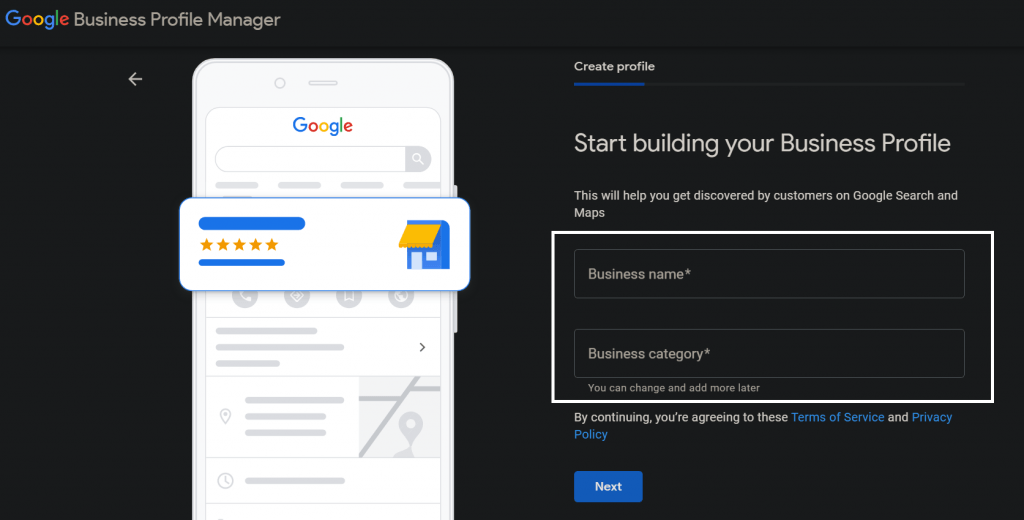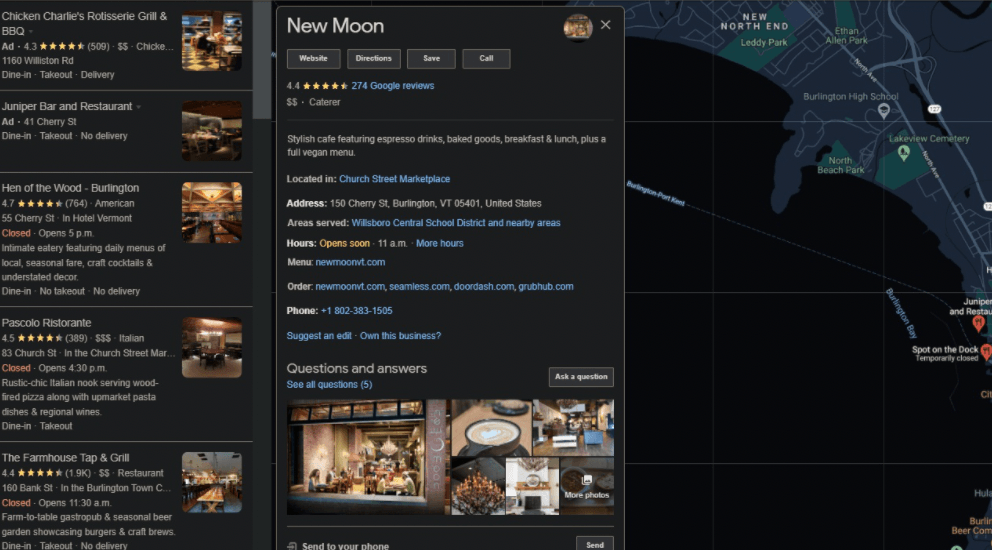Google’s local search algorithm includes a proximity factor, which is just another way of saying that Google takes your location into consideration when you search for a local keyword.
That happens even when the searcher doesn’t include a city name or a “close to me” in their search query.
Any company or business that has a physical, brick and motor location or serves a larger geographic area can benefit from learning local SEO strategies.
In fact, in a 2021 study done by Reviewtrackers, they found that 42% of millennials who perform a local search end up visiting the business they searched for. And, 50% of those searchers are searched while on a mobile device.
Ready to learn all about local on-page optimization?
Keep reading!
What is On-page Optimization?
On-page SEO refers to the methods and practices of optimizing a web page to improve search rankings and bring in more organic traffic. In addition to publishing high-quality, and relevant content, on-page SEO includes optimizing your headlines, HTML tags, meta descriptions, and header images.
Expertise, authoritativeness, and trustworthiness are all considered when optimizing your on-page SEO.
Meta tags
Meta tags are simply components that give important information about pages to search engine crawlers and they are usually located in a head section of HTML code.
Metadata
The term metadata refers to several things such as title tags, meta descriptions, and headers.
Meta titles are the first part of any website a user sees. The meta title holds a lot of valuable information AND IS considered one of the strongest elements that affect rankings for targeted keywords. That’s why it’s so important to include the keyword you want to rank for you in your title.
A meta description is basically just a small summary of information that describes what a webpage is all about and is generally used for previews in search results.
Just a quick mention, Google tends to rewrite meta descriptions about 92% of the time; however, if you want to have control over what your audience sees in your meta description, then it’s best to write one yourself and hope Google doesn’t change it.
Heading tags are used to display a page’s logic to both readers and crawlers. They might not be mentioned as much as meta tags, but they are important enough to be considered a ranking factor.
How Do You Optimize for Local Search Results?
Not sure what to do? Here are a few places to start:
Rank your landing pages
If you serve multiple cities, you can create city-specific landing pages. This is a common workaround for a business that only has 1 location, or does not have an office, but serves an entire area.
For example, your SEO-friendly URLs might look a little like this:
yourwebsite.com/suburb-1/
yourwebsite.com/suburb-2/
yourwebsite.com/suburb-3/
This will allow you to rank organically in places where you may not have a physical office.
Here are some ranking factors for local SEO landing page optimization:
- Your city and state in your landing page title
- Your click-through rate from SERPs
- Topical keyword relevance
- Authority of inbound links to landing pages
- URLs
- Product or service keyword in landing page title
If you have a couple of locations, make sure that you mention them on the service pages, and then ensure that you have created a clear link between your service and the locations you currently occupy.
Incorporate internal links
In order to be able to create lots of internal links, you have to have a lot of internal pages.
Your internal links should use anchor text as opposed to linked images. Image links are okay, however, images shouldn’t be the main source of links especially if the images are alt-tagged.
You may have never heard of deep linking, or are a little unclear about what it means. So, let me explain: deep linking is an SEO tip where hyperlinks link to a webpage with precise content rather than a contact page or a homepage.
Use local search results tools
Thanks to a drastic combination of increased competition and less space for businesses in map packs, you need to use the best tools out there to ensure that your website ranks in search engines.
Here are the most widely used tools for local SEO:
- The HOTH’s Local SEO Business Listing Audit: This tool is a fantastic way to find citations. Just enter your business information and get a free report!
-
Google Business Profile (GMB): Google Business Profile (formally known as Google My Business) is the most widely used tool for getting exposure for your local business. The best part about it is that it’s totally free!
-
PageSpeed Insights: Page speed is one of the major rankings for bounce rate. Google can even penalize slow-loading pages and rewards pages that load faster.
-
Google Link Generator: Google’s link generator makes it super easy to create a direct link to review your business. It isn’t free but it’s convenient and easy to use.
-
Yext: Yext is a local digital marketing tool that helps small businesses boost brand awareness, drive traffic, and boost conversion rates which means more sales for your business!
-
Moz Local: This tool helps you increase the visibility of your company by making sure that your listings are accurate in every directory. Moz submits your information to those directories and other data aggregators and manages your listings with a dashboard.
Perform local keyword research
Implementing the right keywords is vital to on-page success. Any business owner should know about Google’s Keyword Planner Tools and The HOTH’s Keyword Planner Tool that is powered by Google.
Keyword planning shows how many people are searching for specific keywords. You may also not want to use your exact location such as your city, but other places as well that are close to your area.
Create a Google Business Profile
Let me give you a quick rundown of creating a Google Business Profile. Open your dedicated website and create a profile in your Google account at this link: https://business.google.com/create
Check to see if you have already verified your business account, if you have then great! If not, you need to.
Next, you need to put your business name in its main category. Such as a business type.
Then you want to select if you want your potential customers to see your business address, and that’s a pretty important part if you want customers to visit your workplace.
If you do want your customers to see your information, you will want to put in the following information:
- Country
- Address
- City
- Postal code (if any)
- Enter the physical location of your business
You may then need to enter your contact information for Google’s verification process.
Fill in the basic information for your company and then you can begin the optimizing process of inserting keywords and other relevant links and information for your customers. Images are also an important part of local SEO, especially if you’re a restaurant.
Optimize for voice search
Voice search is one of the fastest-growing types of search for Google, Bing, and other search engines. In fact, 55% of users do voice searches to ask a question on a smartphone according to a case study performed by Perficient
So, it’s safe to say that voice searching is the future of searches because it’s easy, convenient, and allows people to multitask while still getting the answers they need. It’s also a safe bet to mention that
With voice technology improving at a rapid pace, it’s important to make sure that your website is optimized for voice search as well as SEO.
Keep your NAP consistent
Make sure you display your name, address, and phone number combination on your website, and preferably in schema format, but more on that later.
Make sure that this NAP is consistent with your business listings.
P.S. Don’t forget to put your business hours!
Embed a Google Map
It’s a great idea to embed a Google map to your location so that users can easily find it. If you’re a little unsure of how to do this let me give you a quick walkthrough.
- Open Google Maps
- Go to directions, map, or even street view
- In the top left click on, “Menu.”
- Click “share” or embed map
- To the left, pick the size you want by clicking the down arrow
- Copy the text in the box then paste it into the HTML of your website or blog
That’s it! You’re more visible to your audience.
Include clear calls to action
Not only do you want people to visit your website, but you also want them to become customers. Make sure that your phone number is clearly and prominently displayed and that there are easy ways to contact you. Guide the user and use CTAs to tell them what to do next (call you, request a quote, etc).
Include reviews & testimonials
Displaying reviews on your site will help improve conversions, giving users confidence in your service. Google Business reviews are also an important part of getting more visibility on Google’s map packs.
Make it mobile-friendly
More than 90% of people use mobile devices to access the internet. Google also has a large focus on mobile-friendly website. You’ll want to use Google’s mobile-friendly test to make sure your website displays correctly on mobile devices. If your website doesn’t pass the test, you should consider a website re-design.
Local business schema
Before I begin, this bit is a little technical so, I’ll break it down some. Schema markup is a way of adding AI readable information to your content. It’s used by search engines to gain a good understanding of your website so they can index it correctly. Schema markups use microdata to write information to HTML, which then gets read by search engines.
Here are some common methods of adding this type of data to your web pages:
- Microformats
- Microdata
- JSON-LD
- RDFa
Before you start messing with your HTML code, it would be best to review what is currently already placed on your website. It’s not recommended to switch to JSON-LD markup if you are already using a different method. You can do this by checking it in Google Search Console.
Because Google uses the geolocation of a user to help give them the best search results, it’s a good idea to take into consideration your service area and to make sure information is correct and up to date on all social media platforms and webpages.
Local On-Page Optimization Can Help Your Business Grow
By taking the time to invest in local on-page optimization, you can help set your business up for success now and in the future.
If you’d rather keep all this to the professionals, The HOTH has a ton of experts waiting to help you with anything local SEO-related and more.Sign up for free and book a call today!





